The small town of Haymarket, VA (pop. 1,959), located about 35 miles south of Washington DC, is historically known as the “crossroads of where heritage meets progress.”
For years, one of those “crossroads”—Interstate 66 and Route 15—has been the site of some significant traffic congestion. During peak commute times it is not unusual for vehicles to be backed up a mile or more on the interstate waiting to exit onto US 15.
There is “progress” toward providing a solution. Last year, the Virginia Department of Transportation (VDOT) awarded a $36 million contract to Lane Construction of Chantilly, VA, to design and build a diverging-diamond interchange (DDI) on US 15 at Interstate 66. The innovative concept of managing traffic made its debut in Springfield, MO, in 2009. Since then, the design has been used effectively in more than 50 locations throughout the United States.
The primary difference between a DDI and a conventional diamond interchange is the directional crossovers on either side of the interchange. This eliminates the need for left-turning vehicles to cross the paths of oncoming traffic. Improved traffic management and safety are the two main goals of the DDI system.
The VDOT says the Haymarket location is the third DDI in the state, designed to handle more than twice the left-turning volumes of a conventional diamond interchange, and it is expected to significantly reduce the number of points where vehicles could collide, from 32 to 18.
The implementation of this design at the Haymarket site includes the construction of two longer bridges to carry US 15 traffic over the interstate with two crossover intersections; ramp and highway improvements; wider intersections with additional turning lanes; a new path for pedestrians and bicyclists; and retaining walls, lighting, and fencing.
Selecting the Right Equipment
This type of construction project is the perfect fit for Lane Construction, the nation’s largest highway contractor as ranked by Engineering News-Record, a trade publication written for the construction industry. For more than 120 years, Lane Construction has been a leader in the construction of highways and bridges. Lane Construction works within several core sectors in the transportation industry, including earthwork, utility relocation, drainage, concrete structures, and asphalt paving. The multi-billion-dollar company also has facilities for aggregate production and the manufacture of concrete and asphalt pavement.
The I-66-US15 Haymarket project is being handled by Lane Construction’s Mid-Atlantic region. In planning for the heavy equipment that would be needed, Aaron Gonzalez, one of the Chantilly-based equipment managers, met with the project engineers and others to decide what machines best fit in each phase of the job.
“Since we are a multi-faceted company, we try to do the entire project ourselves,” says Gonzalez. “Occasionally, we have to sub out some work, but with a very talented group of employees and 800 to 900 different pieces of equipment in the region, we have the capability to handle most of the work ourselves.”
Gonzalez says that when they looked at the different types of functions that had to be performed at the Haymarket site, it was obvious a rubber-tire/wheel excavator would be needed throughout the construction project. The machine had to be large and powerful enough to move barriers, grade, and dig. But it also had to be small enough to work in a fairly narrow space next to barriers and traffic.
The choice for this job was a Doosan DX190W-3 wheel excavator, a 174-net-horsepower machine that rates high in durability, operator comfort, productivity, travel speed, and fuel efficiency.
The company’s first Doosan purchase, a four-year-old used machine, performed so well it opened the eyes of company personnel—both management and equipment operators—to the many benefits of the Doosan brand of excavators.
“Our first unit was a used machine, so our expectations were not very high, and eventually we expected we would have to put money into it,” says Gonzalez. “However, it turned out to be an amazing workhorse. Maintenance expense has been minimal and it’s still working eight to 12 hours a day, five or six days a week.”
His region now has six Doosan excavators, including a second DX190W-3 wheel excavator. That’s the machine based at the Haymarket job.
“Our wheel excavators really stand out in applications where we have to regularly travel around job sites that are crowded and narrow,” says Gonzalez. “We use our two DX190W-3 wheel excavators anywhere we can because they are so versatile. They do a very good job of digging and moving items such as trench boxes and barriers.”
Gonzalez reports that the DX190W-3, which will be working at the Haymarket job site from start to finish (2017), is ideal because of its ability to work next to traffic. “The DX190W-3 is perfect when we are working next to a heavy volume of traffic and where excavator maneuverability is a must,” says Gonzalez. “So, too, is versatility and productivity. The DX190W-3 is a big help on this project.”
Another DDI
A bigger Doosan excavator—a DX350LC-3 crawler model—is part of the equipment fleet at a similar project in Roanoke, VA. That’s where Lane Construction is working on a $38-million design-build contract to complete the partial interchange at I-581 and Valley View Boulevard at exit 3C in the city of Roanoke. The partial interchange was constructed in 1999. Work will include building ramps to and from the interstate, widening the bridge, installing sound walls, lighting, new signals, and repaving. This project will also be an implementation of the DDI concept.




